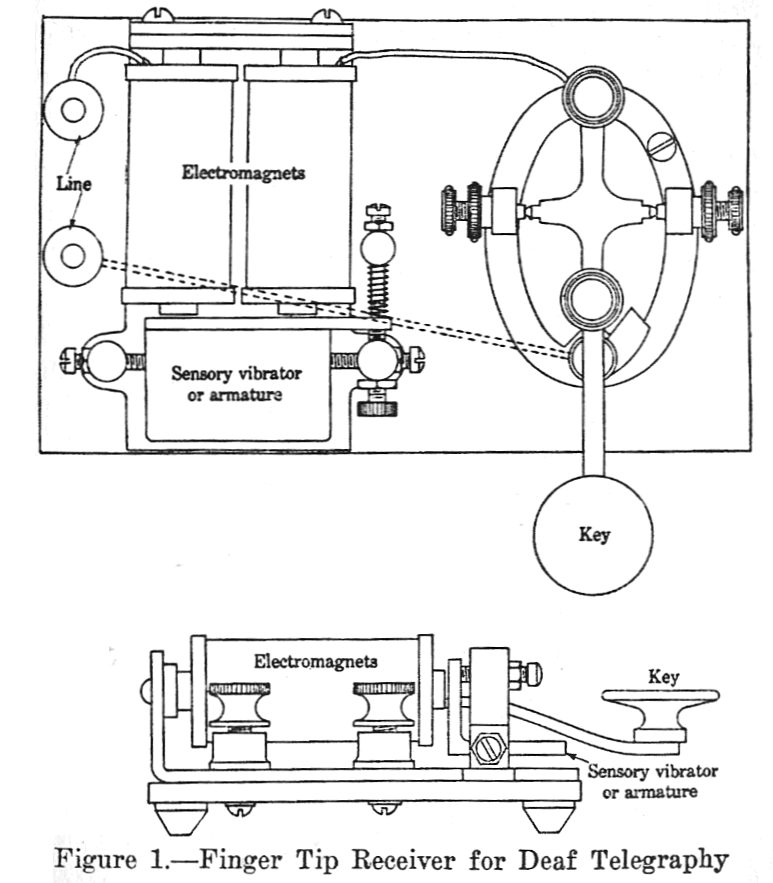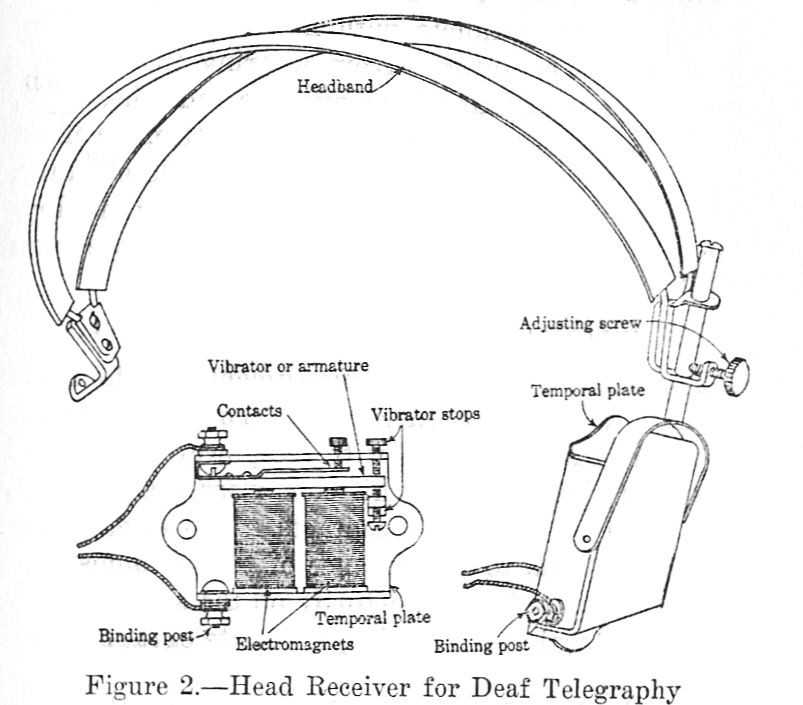|
TELEGRAPHY FOR THE DEAF
*1 INTRODUCTION For the purpose of opening another field of occupation to the deaf the Western Pennsylvania School for the Deaf, cooperating with the Bureau of Mines, Department of the Interior, has designed and built instruments by which the deaf can qualify as telegraph operators. It has been recognized for some time that the deaf are susceptible to musical vibrations; in fact, most of the schools for the deaf in the United States include rhythmic vibration as a part of their curriculum. Musical vibration is said to better the tone and quality of the voice, also to stimulate latent hearing. In some of the schools for the deaf, during chapel services, the "singing" of songs and hymns is accompanied by the piano. While the deaf do not reproduce the tones as given by the piano, they do follow the rhythm. Again it is generally known by physicians that the tactile (touch) sense is more acute than either the auditory or visual. Experiments conducted by Miss Rachel E. Dawes, principal of the primary and intermediate departments of the Western Pennsylvania School for the Deaf, while a student in the University of Pennsylvania, confirm these views. She found that the shortest latent period after stimulus was recorded for the tactile reaction, next for the auditory, and longest for the visual. Later experiments at the Bureau of Mines in comparing auditory, visual and sensory instruments, gave results which proved that a much greater telegraphic speed could be obtained by the instruments utilizing the tactile reactions than for others. The use of the heliograph and similar visual methods as a means of signaling, where a maximum speed of from five to ten words per minute is obtained, shows the slower reactions, as well as the persistence of vision, when using visual instruments. With these facts in mind it was decided to select a group of deaf individuals and to teach them, if possible, to send and receive the Morse telegraph code on an instrument designed to transmit vibrations to the sensory nerve endings. TESTS WITH DEAF SUBJECTS Four male students, ranging in ages from seventeen to nineteen years, were selected from the Western Pennsylvania School for the Deaf, and each was given a complete physical examination with particular study of all nervous reflexes. Three were deaf from infancy and were unable to distinguish any sound whatever, while the fourth was able to hear very loud noises. No other abnormalities or defects were found. DESCRIPTION OF INSTRUMENTS The apparatus used in telegraphy for the deaf is of standard design, with the exception of the sounder or receiving unit. Two different types of receiving units were designed and constructed. The first type, illustrated in Figure 1, utilizes the "sense of touch", or sensory nerve endings in the finger tips. In this instrument the armature or vibrator is caused to vibrate by passing an alternating current through the windings of the electromagnet.
Figure I.-Finger Tip Receiver for Deaf Telegraphy Because of the almost universal use of 60-cycle alternating current in this country, the instrument was designed to operate directly from the nO-volt, 60-cycle power or lighting circuits, thereby avoiding the necessity of using contact-breakers to produce vibration of the armature, when operating on direct current. In receiving, the finger tips are placed lightly on the armature, and the vibrations are transmitted to the sensory nerve endings in the finger tips. In this system of telegraphy, as in radio, each dot or dash comprising the letters of the telegraph code consists of a series of vibrations, the number depending upon the frequency of the current supply and the length of each dot or dash. The frequency used must, of course, be considerably higher than that of the speed being used in transmitting, in order to avoid confusion of the incoming signals. The 60-cycle power supply is of sufficiently high frequency for transmitting at speeds up to about twenty words per minute; at speeds greater than this the dots have a tendency to become "ragged," and difficulty is experienced in receiving, especially when using a vibroplex or similar type of instrument for sending. By using a vibrator to interrupt the current, more satisfactory operation is obtained for higher speeds. The finger tip instrument has the disadvantage of requiring that the operator continually keep one hand on the vibrator while receiving, which is of considerable disadvantage, as it is impossible to use the typewriter and would probably be of considerable hindrance in placing carbons, arranging messages, etc. With this type of instrument it is impossible to call an operator unless he has his fingers on the vibrators. For these practical reasons it is not thought that the instrument just described is of Practical use, although it has proved satisfactory for instruction.
The instrument shown in Figure 2 was built to overcome the objections inherent in the first type, and hils proved satisfactory in preliminary tests.
Figure 2.-Head Receiver for Deaf Telegraphy The instrument consists of a special design heavy armature vibrator mounted on a standard radiophone headband. (See Figure 2.) Instead of mounting the instrument directly over the ear, as with a radiophone to transmit the sounds into the ear, the instrument is placed over the temporal bone directly in front of the ear. Numerous experiments were conducted to determine the most practical position to transmit the vibrations to the sensory nerve endings, taking into consideration convenience in operating, freedom of movement, and fatigue from wearing it. The temporal position seemed to fulfill these requirements most satisfactorily. The instrument is light, weighing but seven ounces, complete with headband, connecting cord, etc. The fatigue from wearing the apparatus is less than that of the average radio head set, which is of advantage, because the instrument must be worn constantly by the operator while on duty. If desired, a visual call or attention signal employing a small light could be used while not wearing headband. CONNECTIONS FOR COMMERCIAL TELEGRAPHY The connections for the instrument are the same as the ordinary line telegraphy. The main-line relays are placed in series with the power supply and the keys. The local circuit comprises the head-set, local battery and relay contacts. The electromagnets are wound to a resistance of twenty ohms, and therefore. operate satisfactorily on the same battery used for local sounders in present telegraphic systems. The deaf students have shown great enthusiasm in the experiments, and apply themselves diligently to practising the code and sending messages to one another. It is believed that these individuals so trained will be capable of filling some positions in this large field of work, and be of more value to industry, and at the same time increase their own earning capacity. ACKNOWLEDGMENTS The writers desire to acknowledge the many helpful suggestions and cooperation of A. O. Fieldner, superintendent, and Dr. R. R. Sayers, chief surgeon, of the Bureau of Mines ; and Mr. A. O. Manning, superintendent of the Western Pennsylvania School for the Deaf. J. J. JAKOWSKY, Asst. Engineer, Radio Investigation, Bureau of Mines, W. J. McCONNELL, Surgeon, Bureau of Mines, TRUMAN L. INGLE, Principal in the Western Pennsylvania School, Pittsburgh, Pa.
|


